10.4 Terrorism
The notion of terrorism was forced into the general consciousness of every single American on September 11, 2001 (figure 10.4). For many in the United States, it was the first time they experienced a terrorist attack on a large scale, even though there have been terrorist attacks in the United States throughout the country’s history. Prior attacks were of a scale such that average Americans could go on with their daily lives without being directly affected. That all changed on 9/11 and has continued to evolve ever since.
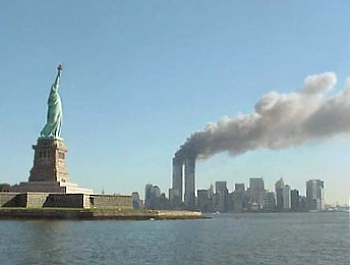
Figure 10.4 The Twin Towers of the World Trade Center burning before they collapsed on September 11, 2001.
10.4.1 Defining Terrorism
Although we all have a general concept of what constitutes terrorism, it is actually somewhat narrowly defined. You may have seen arguments in the news over whether or not certain tragic events (like many mass murders) should be labeled as terrorism.
The State Department uses the following definition when determining what counts as terrorism (Title 22, Chapter 38 U.S. Code § 2656f(d)(2)):
- Terrorism: Premeditated, politically motivated violence perpetrated against noncombatant targets by subnational groups or clandestine agents
According to this definition, the event is planned in advance and is committed for the purpose of sending a political message. Also, the victims are people not engaged in fighting a war, but they are attacked as though they are the enemy by people who see them as such.
The FBI defines terrorism in two distinct ways – international and domestic (FBI, 2022):
- International terrorism: Violent, criminal acts committed by individuals and/or groups who are inspired by, or associated with, designated foreign terrorist organizations or nations (state-sponsored)
- Domestic terrorism: Violent, criminal acts committed by individuals and/or groups to further ideological goals stemming from domestic influences, such as those of a political, religious, social, racial, or environmental nature
The common thread across these definitions is violence and motive. Simply put, terrorist groups or individuals carry out violent acts against innocent victims to send a specific message.
Terrorism can be international or domestic, and within domestic terrorism can be right-wing or left-wing. Both right-wing and left-wing extremists want to bring down the government, but for different reasons. Sociologist Mark Blumberg studied extremists groups and presented his findings to the American Society of Criminology in 1986. He argued,
Leftists usually have urban backgrounds, are highly educated, and include blacks. Extreme right-wing groups consist entirely of white Christians and are often blue-collar and poorly educated. Both types of groups exploit legitimate political issues to attract members. They both also recruit from the military and prison populations. Their criminal offenses are similar and include bombings, murder of law enforcement officers, and attacks on government installations. Both types of groups pose a danger to the United States and need to be monitored.
10.4.2 Domestic Terrorism – Right-Wing Extremism
The Right-Wing terrorist’s goal is to fight change from what they consider to be traditional American values. For this reason, the focus is commonly on resistance to progress regarding race/ethnicity, religious beliefs, reproductive rights, sexual orientation and gender identity, and immigration. In this perspective, white men are in control, women are subservient, and anyone outside of their preferred heterosexual, cis-gendered, native-born collective is seen as a problem.
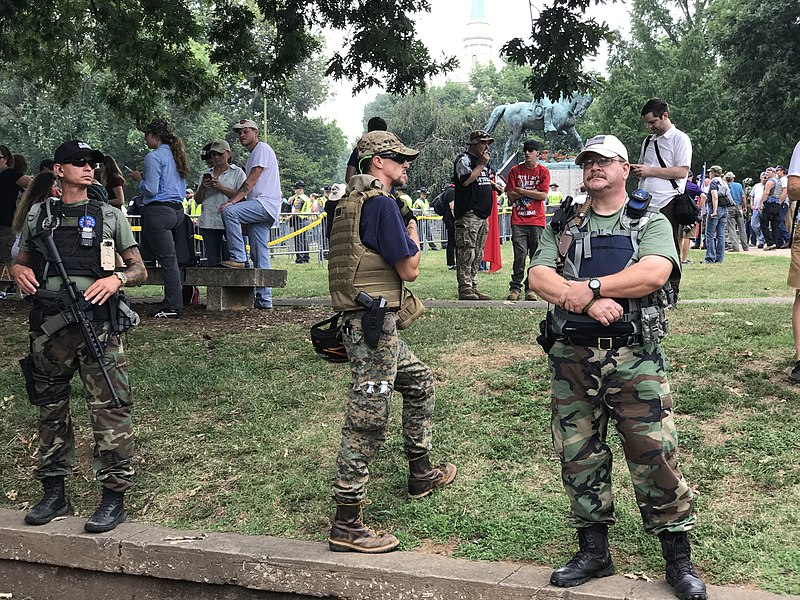
Figure 10.5 Far-right “Three Percenters” patrol Emancipation Park at the Charlottesville “Unite the Right” Rally.
In 2019, Congress passed the “Domestic Terrorism Act” in which they stated, “White supremacists and other far-right-wing extremists are the most significant domestic terrorism threat facing the United States” (Domestic Terrorism Act, 2019). The groups listed in this bill are characterized by traits identified by scholars over two decades earlier as “extremist paramilitary groups oriented toward survivalism, outdoor skills, guerilla training, and outright sedition” (Hoffman, 1987). The Domestic Terrorism Act was created in response to a series of deadly far-right-wing domestic terrorist attacks. Some recent examples cited in the Act include (Domestic Terrorism Act, 2019):
- August 5, 2012 – mass shooting at a Sikh gurdwara in Oak Creek, Wisconsin – one white supremacist shot and killed 6 members of the gurdwara
- April 13, 2014 – mass shooting at a Jewish community center and assistend living facility in Overland Park, Kansas – one neo-Nazi shot and killed 3 civilians
- June 8, 2014 – ambush of police in Las Vegas, Nevada – two supporters of the far-right-wing “patriot movement” shot and killed two police officers and one civilian
- June 17, 2015 – mass shooting at the Emanuel AME Church in Charleston, South Carolina – one white supremacist shot and killed 9 church members
- November 27, 2015 – mass shooting at a Planned Parenthood clinic in Colorado Springs, Colorado – one anti-abortion extremist shot and killed one police officer and two civilians
- March 20, 2017 – murder of one African-American man in New York City – one white supremacist traveled to New York to seek out and kill Black men
- May 26, 2017 – attack in Portland, Oregon on public transit – one white supremacist killed two men and injured a third who were defending two young women being targeted by the white supremacist with anti-Muslim hate speech
- August 12, 2017 – attack in Charlottesville, Virginia at a protest – one white supremacist killed one civilian and injured another nineteen by driving his car through a crowd that was protesting a neo-Nazi rally (figure 10.5)
- October 24, 2018 – mass shooting at a grocery store in Jeffersontown, Kentucky – one white man shot and killed two African-American people
- October 27, 2018 – mass shooting at the Tree of Life Synagogue in Pittsburgh, Pennsylvania – one white nationalist shot and killed eleven members of the congregation
This Act calls for the authorization of offices to monitor, analyze, investigate, and prosecute domestic terrorism that will be responsible for the production of an annual report on domestic terrorism; identification of training requirements and resources; and the creation of joint terrorism task forces, fusion centers, and an interagency taskforce (Domestic Terrorism Act, 2019).
10.4.2.1 Ku Klux Klan (KKK)
A classic example of a right-wing extremist terrorist group is the Ku Klux Klan (KKK). The KKK started in Tennessee in 1865 and consisted of former Confederate soldiers who pledged to fight oppression from the North. Instead of accepting the end of the Civil War, the former soldiers continued to fight for the cause they believed in, seeking vengeance through the violence and intimidation. They were a vigilante group that intimidated southern Blacks and Whites who supported civil rights. After the Jim Crow Laws that secured the domination of Southern Whites, the KKK informally disbanded but would have a significant revival in the 1920s with a focus on fighting immigration.
The KKK claimed to be a white Christian movement. They were anti-Black because of the belief that the Civil War had not ended and slavery should still be in place, and anti-Catholic since so much of the political power in the North was wielded by urban Catholic immigrants. As the KKK progressed in their hate campaign, they included Jews in the 1920s because of large waves of immigration to the United States following World War I. Including the two newest immigrant groups in the United States (Catholics and Jews) illustrates how the KKK’s hate increased because of a fear of immigration to the United States and losing their own dominance as a result. The KKK promoted White America and nationalism. They viewed themselves as 100% American and 100% White Protestant. They used dichotomies such as South vs. North, rural vs. urban, and religious vs. secular to divide the United States and focus their hate. The third rise of the KKK was during the civil rights movement of the 1960s, focusing on preserving segregation despite unfavorable court rulings. Although not often in the public eye any longer, the KKK still operates to support their mission and that of like-minded organizations.
The focus of many of these groups is the concept of “white genocide,” which is the belief that Whites in the United States are being systematically replaced and destroyed because of the Civil Rights Act of 1964 and immigration policy. However, in their desire to form a “white ethnostate” they claim their desire for separation is not because of hate but rather because of the love of the members of their own race.
Though white nationalism was believed to be on the decline in the United States, it has once again reared its ugly head following the presidential election in 2016. Since then, there has been an increase in white nationalist violence and an attempt for white supremacist, right-wing groups to become more mainstream with their ideology and beliefs that can influence future action.
In the 1990s, there were two incidents (Ruby Ridge and the Branch Davidians) that fueled these movements. Groups in the “patriot movement” used these incidents as examples of government overreach and their need to bring down this oppressive regime. The patriot movement is a term that encompasses all right-wing extremist groups, nationalist movements, militias, sovereign citizens (those who do not recognize the U.S. government as having authority over them), and tax protesters (those who refuse to pay taxes). These groups are also fans of conspiracy theories, which we will discuss later in this chapter.
10.4.2.2 Ruby Ridge
On August 21st, 1992, federal agents came onto the property of Randy Weaver in Idaho to arrest him on a warrent for weapons charges. Instead of giving in to the arrest, Randy Weaver, his wife and children (one son and three daughters), and family friend Kevin Harris staged a resistance. During an 11-day siege, Weaver’s 14-year-old-son Sammy, wife Vicki, and dog Striker were all killed. All of the federal law enforcement agencies involved in the siege later faced disciplinary repercussions and were all found guilty of serious wrongdoing.
The same agencies, and even some of the same personnel, committed similar harms only six months later outside of Waco, Texas.
10.4.2.3 Branch Davidians
On February 28th, 1993, with the belief that the Branch Davidians (a self-contained religious group living on a rural compound just outside of Waco, Texas) were stockpiling weapons at their ranch, the FBI and ATF raided the compound (figure 10.6). During the initial raid, there was a shootout in which four federal agents were killed, setting off a 51-day standoff. On April 19th, 1993, the joint government agencies rammed the building with tanks and launched a tear gas assault on those inside. The structure caught fire and 76 Branch Davidians (including 28 children) were killed in the flames.
Again, the federal agencies were found to have made grievous mistakes that have since fueled right-wing extremist groups and conspiracy theorists, adding to the narrative that the government is an evil entity.
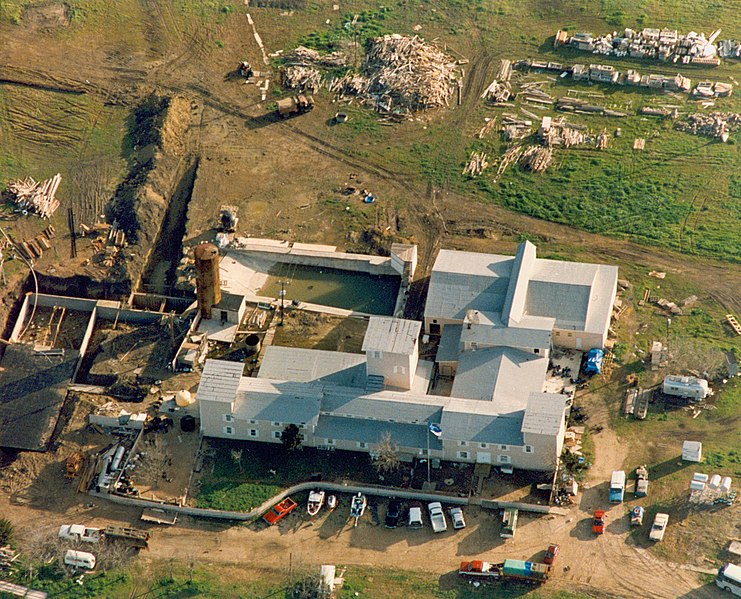
Figure 10.6 Branch Davidian compound near Waco, Texas.
10.4.2.4 Oklahoma City Bombing
It is claimed that the events at Ruby Ridge and Waco were the fuel that fired domestic terrorists Timothy McVeigh and Terry Nichols who bombed the Murrah Federal Building in Oklahoma City, Oklahoma (figure 10.7). The Murrah Federal Building housed several federal government offices and a daycare center for their children. McVeigh, with the bomb-building support of Nichols, detonated a bomb inside a truck full of explosives that he had parked in front of the building. The explosion killed 168 people (including six children) and injured another 680. McVeigh was later quoted as saying, “I didn’t define the rules of engagement in this conflict. The rules, if not written down, are defined by the aggressor. It was brutal, no holds barred. Women and kids were killed at Waco and Ruby Ridge. You put back in [the government’s] faces exactly what they’re giving out. …I wanted the government to hurt like the people of Waco and Ruby Ridge had.”
Both McVeigh and Nichols were former military, and both became radicalized after Ruby Ridge and Waco. The importance of each of their military service should not be overlooked. In 2009, the Department of Homeland Security issued a report warning that disgruntled military veterans are at risk of recruitment and radicalization by right-wing extremists that will try to exploit their skills and knowledge they have obtained from their military training. When the report was released, Republican John Boehner demanded that the agency apologize to veterans. However, the report states a trend that did not begin with Timothy McVeigh and Oklahoma City and could be traced back to the Civil War and the creation of the Ku Klux Klan. The report contained further warnings of the belief that white supremacists were learning military techniques in the U.S. armed forces to later be used against American civilians.

Figure 10.7 Oklahoma City bombing.
10.4.2.5 Conspiracy Theories
The patriot movement spreads anti-government conspiracy theories, supporting their belief that the government has been infiltrated and subverted, making it no longer legitimate (which also means the laws are not legitimate and do not apply to them).
Some of the more popular conspiracy theories in the movement include:
- New World Order – A secretive power elite has a global agenda to rule the world through an authoritarian one-world government. When this happens, followers of the patriot movement must be prepared for mass hysteria and ready to launch an apocalyptic militia uprising to protect themselves.
- 9/11 – The collapse of the Twin Towers and 7 World Trade Center were the result of controlled demolitions by the U.S. government instead of the impact and fire causing the buildings to collapse. Some even place full responsibility for the 9/11 attacks on the U.S. government, believing they were secretly behind the whole thing.
- QAnon – A group of Satanic, cannibalistic, pedophiles are operating a global child sex trafficking ring made up of members of the Democratic party, Hollywood actors, business tycoons, and medical experts. The claim is also that there is a pedophile sex trafficking ring run in the basement of a Washington, D.C. pizzeria.
- Chemtrails – The water condensation trails (chemtrails) that are formed by engine exhaust behind airplanes and look like lines or streaks of white clouds are filled with chemical or biological agents. These chemicals are responsible for weather modification, psychological manipulation, human population control, and more.
There is an extensive list of conspiracy theories supported by the right-wing extremist groups in the patriot movement. They may seem like harmless lies, but they lead to terroristic behavior that is dangerous. For example, the QAnon claim that there was a pedophile sex trafficking ring run out of the basement of a Washington, D.C. pizzeria (otherwise known as “Pizzagate”) ended with a man traveling to the Comet Ping Pong pizzeria from North Carolina and shooting a rifle inside the restaurant. The restaurant owner and staff also received death threats from people who fell for this conspiracy theory.
QAnon believers, along with several groups under the umbrella of the patriot movement, were responsible for the attack on the U.S. Capitol Building on January 6th, 2021. There were five deaths during the attack, four officer deaths by suicide following the attack, and 138 police officers injured. The outlandish claims of these conspiracy theories are far from harmless and should be taken seriously.
10.4.3 Domestic Terrorism – Left-Wing Extremism
Left-Wing Extremists in the United States are associated with the goal of overthrowing the government not to create their own like the right-wing extremists, but rather to replace the capitalist system with communist or socialist societies. The left-wing terrorist claims they are fighting for equality, human rights, animal rights, and environmentalism by creating significant change in society, albeit through violent means. Left-wing extremism has also been called anarchist terrorism for their uprising against the ruling class and claims to offer hope to those who are marginalized by the wealthy and powerful.
10.4.3.1 The Weather Underground
The Weather Underground was the most active and well-known leftist extremist group committed to political violence in the late 1960s and early 1970s. They were a group of primarily college-educated individuals who were inspired by communist ideologies and embraced violence as a way to protest the Vietnam War, racism, and other social issues.
The Weather Underground was a splinter group from the more significant Students for a Democratic Society (SDS). The SDS was a nonviolent student group that saw the inequality that was present in the United States and believed our government was not paying attention and even creating marginalized groups throughout the country. The members of the SDS grew up in white suburban America and saw their parents live comfortable lives at the expense of the poor in their society.
10.4.3.2 Black Liberation Army
The Black Liberation Army was a Black nationalist paramilitary group that fought for revolution from 1970 to 1981. They promoted war against the U.S. government for the liberation of Black people. They are responsible for several bombings, killings of police officers, killings of drug dealers, robberies, and prison breaks.
Some members of the Black Liberation Army are still on the FBI’s Terrorism Most Wanted List. For example, Joanne Chesimard fled after escaping from prison while serving a life sentence. According to the FBI (2022),
On May 2, 1973, Chesimard, who was part of a revolutionary extremist organization known as the Black Liberation Army, and two accomplices were stopped for a motor vehicle violation on the New Jersey Turnpike by two troopers with the New Jersey State Police. At the time, Chesimard was wanted for her involvement in several felonies, including bank robbery. Chesimard and her accomplices opened fire on the troopers. One trooper was wounded and the other was shot and killed execution-style at point-blank range. Chesimard fled the scene, but was subsequently apprehended. One of her accomplices was killed in the shoot-out and the other was also apprehended and remains in jail. In 1977, Chesimard was found guilty of first degree murder, assault and battery of a police officer, assault with a dangerous weapon, assault with intent to kill, illegal possession of a weapon, and armed robbery. She was sentenced to life in prison. On November 2, 1979, Chesimard escaped from prison and lived underground before being located in Cuba in 1984. She is thought to currently still be living in Cuba.
10.4.3.3 May 19th Communist Organization (M19CO)
May 19th Communist Organization (M19CO) was a revolutionary organization active during 1978 to 1985. It was formed by former members of The Weather Underground and the Black Liberation Army, also including members of the Blank Panthers. May 19th marks the birthdays of both Malcolm X and Ho Chi Minh. Their goals were to free political prisoners in U.S. prisons, to steal from the wealthy to fund their operations, and commit bombings and other terrorist acts against the U.S. government. They planned to eventually move the United States from a capitalist economy to a communist society. During their final few years, they committed several bombings and robberies.
Some members of M19CO are still on the FBI’s Terrorism Most Wanted List. For example, Donna Joan Borup is on the run following a violent anti-apartheid demonstration at JFK International Airport in New York on September 26th, 1981. According to the FBI (2022),
During the riot, Borup allegedly tossed a caustic substance into the eyes of a Port Authority Police Officer, leaving him partially blind. At the time, Borup was a member of the May 19th Communist Organization, a Marxist-Leninist organization which advocated the armed revolution and violent overthrow of the United States Government. Borup, along with some accomplices, was arrested and released on bail pending trial in May of 1982. On May 20, 1982, an arrest warrant was issued for Borup after she failed to appear for her trial on a Queens County indictment which charged her with riot in the first degree and assault in the first degree. On September 14, 1982, a federal arrest warrant was issued for Borup in the Eastern District of New York and she was charged with unlawful flight to avoid prosecution.
10.4.3.4 United Freedom Front
The United Freedom Front was founded on Marxist ideologies of anti-materialism and anti-classism. Active in the 1970s and 1980s, this group is responsible for at least twenty bombings and nine bank robberies. They targeted large corporations, courthouses, and military facilities with their bombs.
10.4.3.5 Antifa
Antifa (short for antifascist action) is a political movement consisting of various small groups and individuals united by their militant opposition to fascism, racism, and other right-wing extremist ideologies. While most of their activism is non-violent, they are also responsible for harassment, property damage, and digital activism like public shamings on the internet. The public “outing” is to let people know their neighbor is a Nazi or to let employers know they have hired a white supremacist.
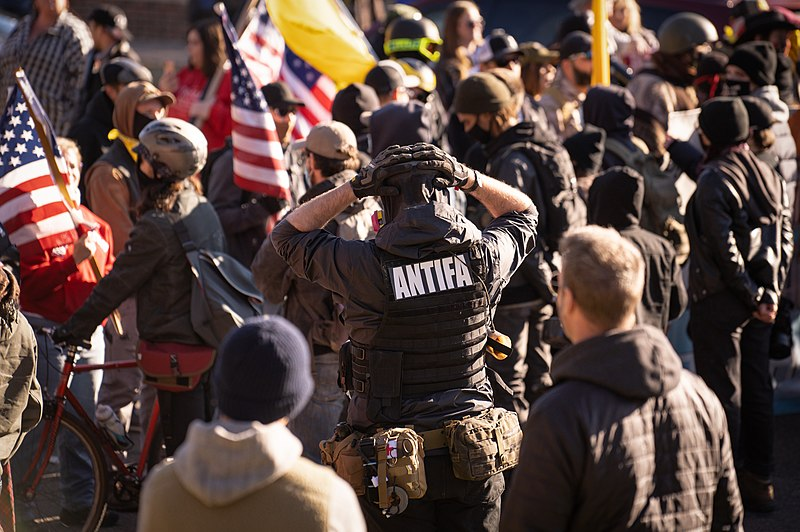
Figure 10.8 November 28, 2020 – St. Paul, Minn. — A man with an ANTIFA patch on the back of his vest arrives at the Proud Boys, Trump, Stop the Steal rally.
Members tend to subscribe to anarchist, communist, and socialist views and work to prompt a revolution that overthrows the current U.S. government to destroy the formalization of authority, capitalism, fascism, and the state (figure 10.8). Fascism supports a military-style dictatorship that denies individual rights and does not allow for any opposition. Antifa wants the exact opposite – no centralized government and full individual rights. Some argue antifa is just as dangerous as their right-wing counterparts because of the anti-government stance, whether they are fighting for positive causes or not.
10.4.4 International Terrorism
In addition to acts carried out by domestic right-wing and left-wing extremist groups, we also have to be on the lookout for threats from international terrorist organizations. The attacks on September 11th, 2001 were the largest incidents of international terrorism in the history of the United States. In a coordinated attack, two hijacked planes flew into the World Trade Center towers in New York City killing 2,759 people and injuring another 8,700. Another hijacked plane flew into the Pentagon killing another 189 people and injuring 200. A final plane that was heading for the White House instead crashed into a field in Pennsylvania (thanks to passengers onboard who overtook the hijackers) killing another 45 people. Nineteen militants from the Islamic extremist group al Qaeda were responsible for these suicide attacks that forever changed how law enforcement approaches terrorism.
Of particular note is that some of these terrorists lived in the United States for more than a year before the attacks and had even taken flying lessons at American commercial flight schools. Others were able to sneak into the country shortly before the attacks. They also easily smuggled box cutters and knives onto the flights, which they used to hijack each of the planes. This may be hard to imagine for anyone who did not experience airline travel prior to 9/11.
Although 9/11 was the largest and the one that caused the most changes in our everyday lives (which will be discussed more in Law Enforcement Responses below), it is far from the only international terrorist attack we have experienced in this country. Following are just some of the recent examples:
- On October 31st, 2017 in New York City, 29-year-old Sayfullo Habibullaevic Saipov drove a truck into people on a bike path, killing 8 and injuring 12 “in the name of ISIS ” according to a note he brought to the attack.
- On June 12th, 2016, 29-year-old Omar Mateen shot and killed 49 people and injured another 53 people at a nightclub in Orlando, Florida. He called 911 during the shooting to take credit and claim allegiance to Abu Bakr al-Bachdadi, leader of the terrorist group ISIS.
- On December 2nd, 2015, Syed Rizwan Farook and Tashfeen Malik killed 14 people and injured 22 others at a holiday party for employees of the San Bernardino County Department of Public Health where Farook was an employee. The FBI determined Farook and Malik had become radicalized over the internet, becoming committed to jihadism and martyrdom. After visiting Saudi Arabia in the years leading up to attack, the two stockpiled weapons, ammunition, and bomb-making equipment, along with a support system of like-minded family and friends.
- On November 5th, 2009 at the Soldier Readiness Center at Fort Hood in Texas, Nidal Hasan killed 13 and injured 44 in a shooting motivated by his devotion to the Yemen-based Imam Anwar al-Awlaki.
10.4.4.1 International Terror Groups
The U.S. Department of State lists ISIS, al-Qaeda, and Hezbollah as groups who continue to plot against the United States (figure 10.9). The FBI lists the following individuals on the Terrorism Most Wanted list:
- #1: Abd Al Rahman Al Maghrebi, member of Al-Qaeda known for committing acts of terrorism against the United States
- #3: Sajid Mir, chief planner of attacks in Mumbai that killed six Americans in the name of the Lashkar-e-Tayyiba (LeT) terrorist organization
- #4: Abdullah Shair Khan, member of Taliban and Haqqani Networks
- #6: Ahlam Ahmad Al-Tamimi, participated in 2001 terrorist attack of pizza restaurant in Jerusalem that killed 15 people, including to Americans
- #12: Liban Haji Mohamed, provided material support to Al-Qaeda and is a member of the Al-Shabaab terrorist organization
- #14: Raddulan Sahiron, committed kidnapping in the name of terrorist organization Al Harakat al Islamiyyah, also known as the Abu Sayyaf Group
- #15: Shaykh Aminullah, provided material support to Al-Qaeda, the Taliban, and anti-coalition militias, part of Pakistan-based terrorist group Lashkar-e-Tayyiba (LeT)
- #16: Ahmad Abousamra, took multiple trips to Pakistan and Yemen where he tried to get military training to kill American soldiers overseas
- #18: Jehad Serwan Mostafa, member of al-Shabaab, a Somalia-based terrorist organization
- #19: Jaber A. Elbaneh, provided material support to Al-Qaeda
- #20: Abd Al Aziz Awda, one of the original founders and the spiritual leader of the Palestinian Islamic Jihad (PIJ) and has conspired to commit bombings, murders, extortions, and money laundering
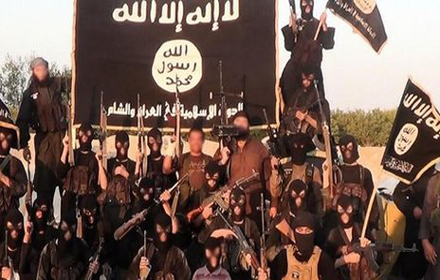
Figure 10.9 Terrorist Group ISIS.
Of these Top 20 on the FBI’s Terrorism Most Wanted list, notice there are only 11 listed here. That is because the other 9 are wanted for acts of domestic terrorism. Of those wanted for international terrorism listed here, the groups identified are Al-Qaeda, Lashkar-e-Tayyiba (LeT), Taliban, Haqqani, Al-Shabaab, Al Harakat al Islamiyyah (also known as the Abu Sayyaf Group), and Palestinian Islamic Jihad (PIJ). Anti-American and anti-Western sentiment is common across all of these groups. For this reason, law enforcement must keep watch on all of them at all times.
10.4.5 Licenses and Attributions for Terrorism
“Terrorism” by Curt Sobolewski is licensed under CC BY 4.0.
Figure 10.4 The Twin Towers of the World Trade Center burning before they collapsed on September 11, 2001, National Park Service, Public domain, via Wikimedia Commons.
Figure 10.5 Far-right “Three Percenters” patrol Emancipation Park at the Charlottesville “Unite the Right” Rally, Anthony Crider, CC BY 2.0, via Wikimedia Commons.
Figure 10.6 Branch Davidian compound near Waco, Texas, the Federal Bureau of Investigation, Public domain, via Wikimedia Commons.
Figure 10.7 Oklahoma City bombing, usacetulsa, CC BY 2.0, via Wikimedia Commons.
Figure 10.8 November 28, 2020 – St. Paul, Minn. — A man with an ANTIFA patch on the back of his vest arrives at the Proud Boys, Trump, Stop The Steal rally, Chad Davis from United States, CC BY 2.0, via Wikimedia Commons.
Figure 10.9 Terrorist Group ISIS, State USA, CC BY-SA 4.0, via Wikimedia Commons.
